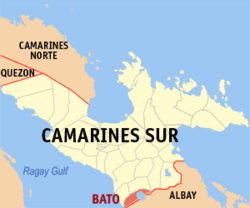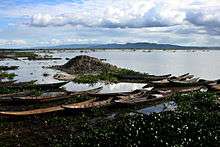Bato, Camarines Sur
| Bato | ||
|---|---|---|
| Municipality | ||
|
Municipal hall | ||
| ||
 Map of Camarines Sur showing the location of Bato | ||
.svg.png) Bato Location within the Philippines | ||
| Coordinates: 13°21′22″N 123°21′50″E / 13.3561°N 123.3639°ECoordinates: 13°21′22″N 123°21′50″E / 13.3561°N 123.3639°E | ||
| Country | Philippines | |
| Region | Bicol (Region V) | |
| Province | Camarines Sur | |
| District | 4th district | |
| Barangays | 33 | |
| Government[1] | ||
| • Mayor | Jeannette O. Bernaldes | |
| Area[2] | ||
| • Total | 107.12 km2 (41.36 sq mi) | |
| Population (2015 census)[3] | ||
| • Total | 52,137 | |
| • Density | 490/km2 (1,300/sq mi) | |
| Time zone | PST (UTC+8) | |
| ZIP code | 4435 | |
| IDD : area code | +63 (0)54 | |
| Income class | 3rd class;[2] partially urban | |
Bato (Rinconada Bikol: Banwāan ka Bato; English: Municipality of Bato; Filipino: Bayan ng Bato) is a third class[2] rural municipality in the province of Camarines Sur, Philippines. According to the 2015 census, it has a population of 52,137 people.[3]
The municipality of Bato, like Buhi town, is home to a lake teeming with various kinds of fishes. Sinarapan, the world's smallest commercially harvested fish, occupies the waters of Lake Bato. Also present, the lake abounds with tilapia housed in fish cages.
History
This town was formerly called as "Kaliligno" or "Caligno" named by the natives that settled along the river area. See also, the Bato's native Pre-Spanish Era Early Settlers.
This small village later was elevated into a status of a town under the decree of Spanish Superior Government on February 15, 1753. Years back, a parish was already existing which was also made under the same decree. This parish adopted "The Most Holy Trinity" as its patron; its feastday is celebrated every Sunday after the Pentecost.Known for best noodles called pansit bato.
Barangays
Bato is politically subdivided into 33 barangays.[2]
- Agos
- Bacolod
- Buluang
- Caricot
- Cawacagan
- Cotmon
- Cristo Rey
- Del Rosario
- Divina Pastora (Pob.)
- Goyudan
- Lobong
- Lubigan
- Mainit
- Manga (Mangga)
- Masoli
- Neighborhood
- Niño Jesus
- Pagatpatan
- Palo
- Payak
- Sagrada (Sagrada Familia)
- Salvacion
- San Isidro (Pob.)
- San Juan
- San Miguel
- San Rafael (Pob.)
- San Roque
- San Vicente
- Santa Cruz (Pob.)
- Santiago (Pob.)
- Sooc
- Tagpolo
- Tres Reyes (Pob.)
Demographics
| Population census of Bato | ||
|---|---|---|
| Year | Pop. | ±% p.a. |
| 1990 | 35,294 | — |
| 1995 | 38,771 | +1.78% |
| 2000 | 42,739 | +2.11% |
| 2007 | 44,437 | +0.54% |
| 2010 | 48,306 | +3.08% |
| 2015 | 52,137 | +1.46% |
| Source: Philippine Statistics Authority[3][4][5] | ||
In the 2015 census, the population of Bato, Camarines Sur, was 52,137 people,[3] with a density of 490 inhabitants per square kilometre or 1,300 inhabitants per square mile.
Only about 58.27% of the household population is considered as literate.
Mother tongue of the majority is Riŋkonāda also known as Bikol Rinconada, one of the languages of Bicol region. The population speaks a different form of Rinconada Bikol called Bato variant, a lowland dialect (sinaranəw). Natives are also conversant with Coastal Bikol, Filipino/Tagalog and English languages.
Religious affiliation:
- Roman Catholicism is the predominant religion, followed by the Iglesia Ni Cristo as the largest minority.
- Other religious denominations include Church of Jesus Christ of Latter Day Saints; United Churches of Christ in the Philippines Seventh Day Adventist; Bible Baptist; Born Again; Jehovah’s Witnesses; Protestants; Aglipay and Islam.
Economy

Majority of employment is within agriculture, fishery, poultry and construction industry groups.
Commerce and industry:
- 96 commercial establishments engaged in retail trade
- 46 commercial establishments engaged in services
- 1 commercial establishment engaged in real estate
- 1 engaged in banking and finance
- 31 industrial establishments
Natural resources include clams, pearls, local shrimps, tabios, and tilapia, particularly within Lake Bato; forest products such as anahaw leaves and local bamboo; non-metallic mineral resources such as white clay among others.
Agriculture Sector:
- 78.087 square kilometers of Agricultural Lands devoted to crop production
- Rice, corn, coconut, root crops, vegetables, and fruit-bearing trees.
- Numerous farm and poultry products found
Tourist attractions

- white sand beaches, white caves, natural falls and springs
- Bato Parish Church considered as Historical landmark
- seven last words at Mount Calvary foot and lacustral procession during town fiesta celebration and the Annual Foundation Day Celebration
Infrastructure
Health
- Municipal Health Center and Barangay Health Stations total bed capacity: Eight (8) beds
- Health personnel numbers only about seventeen (17)
Security
Facilities for police protection include Police Station Headquarters near the Municipal Hall in the Poblacion, Police Substation in Barangay Tres Reyes, Police Outpost in Barangay San Miguel. The bureau of Fire Protection of Bato has about eleven (11) firemen personnel.
Transportation
- 19.550 kilometers of National Roads
- 45,650 kilometers of Provincial Road
- 7.206 kilometers of municipal roads
- 38.683 kilometers of Barangays Roads
- six (6) bridges
- 235 privately owned vehicles
- public utility vehicles and government vehicles
Utilities
Water supply is provided on 3 levels:
- Level I: wells, springs, or water peddlers common in rural barangays and households
- Level II: communal faucet system
- Level III: Bato Water District provides Level III Water Supply Service generally within the poblacion only
Power and electricity:
- Camarines Sur Electric Cooperative (CASURECO) which provides retails electrical supply to the municipality and maintains a substation
- Domestic Consumptions
- 95.18% with total average consumption rate of 35,595.40 KWH/month Industrial and Commercial Consumption have only about 0.48% connections
- Public buildings, streetlights and other account for the remaining 1.72% number of consumption
Communication facilities include telephone/cellular services, postal services, telegraph services, cable television services, and print and broadcast media services.
Education
- 1 private college
- 15 public elementary schools
- 1 private school
- 4 public secondary schools
- 4 private schools
References
- ↑ "Municipalities". Quezon City, Philippines: Department of the Interior and Local Government. Archived from the original on 25 January 2013. Retrieved 7 January 2013.
- 1 2 3 4 "Province: CAMARINES SUR". PSGC Interactive. Makati City, Philippines: National Statistical Coordination Board. Retrieved 7 January 2013.
- 1 2 3 4 "Region V (BICOL REGION)". Census of Population (2015): Total Population by Province, City, Municipality and Barangay (Report). PSA. Retrieved 20 June 2016.
- ↑ "Region V (BICOL REGION)". Census of Population and Housing (2010): Total Population by Province, City, Municipality and Barangay (Report). NSO. Retrieved 29 June 2016.
- ↑ "Province of Camarines Sur". Municipality Population Data. LWUA Research Division. Retrieved 24 July 2013.
External links
| Wikimedia Commons has media related to Bato, Camarines Sur. |
- Philippine Standard Geographic Code
- Philippine Census Information
- Official Site of the Province of Camarines Sur
 |
Balatan | Nabua | Iriga |  |
| |
Polangui, Albay | |||
| ||||
| | ||||
| Ragay Gulf | Libon, Albay |
